Natsuko’s Cyclotouring Reunion in Hokkaido
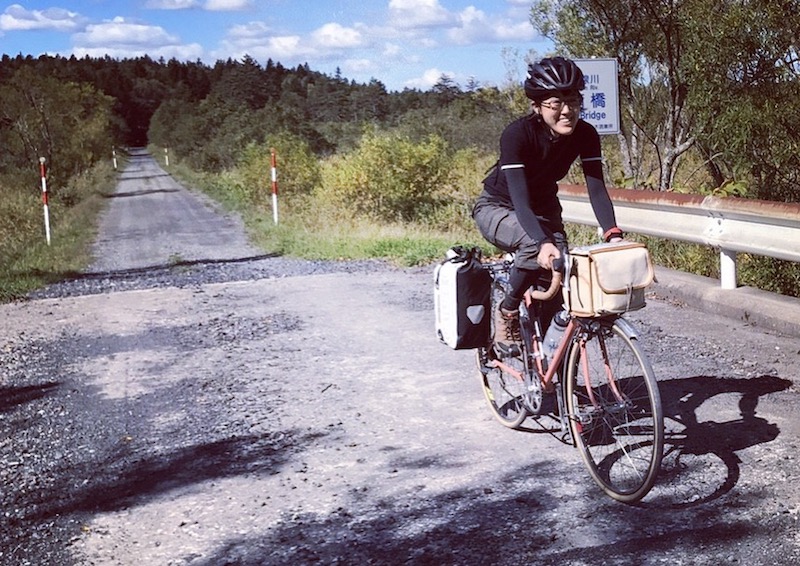
I like bicycles and cyclotouring, but I especially like traveling. When I think about where I want to go next, my heart skips a beat with excitement. Passhunting, visiting Onsen hot springs, eating good meals… During my busy life, it’s easy to forget the small things that make this world so beautiful. When I go cyclotouring, I notice them all the more.
During the last few years, I’ve lived both in Seattle and Tokyo. As I spend more time away from Japan, I notice its beauty even more than I did in the past. This time, I visited the Soya area of Hokkaido, where Ms. K, a friend since college, now lives with her family. For a long time, I’ve wanted to visit her, but the opportunity didn’t present itself.
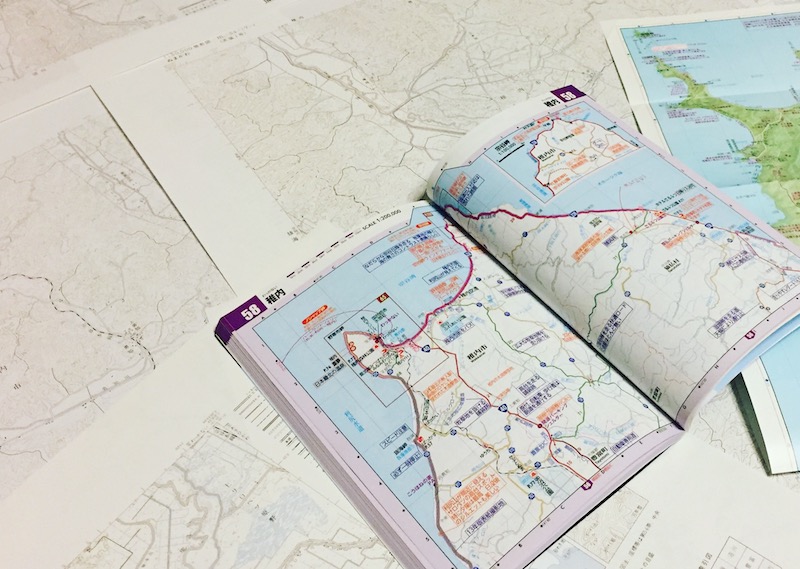
Last autumn, I went to lunch with my best friend, Mr. Y, and we talked about her. He immediately concurred: “Yes, let’s go!” We send a message to Ms. K, and she replied almost immediately: “Anytime! Please come and visit!” It felt like our university days – so easy to make plans.
Our plan quickly grew in scope. While we were in Hokkaido, we should go cyclotouring! So Mr. Y decided to bring his bike as well.

Our schedules didn’t allow traveling together, so we met in Wakkanai, Japan’s northernmost town. I flew from Tokyo. Japan’s baggage handlers are reasonably careful, so I just packed my bike in its lightweight Rinko bag. Mr. Y came by overnight bus.
Our plan was simple: “Let’s meet at 8 a.m. at a small intersection in Wakkanai.” When we were in college, we often met at city parks or railway stations to start our trips. In the early morning, I received a message: “My bus is getting close to the intersection now.” So I left my hotel and cycled over to the meeting point.
Mr. Y was already there. Even though Wakkanai is almost 1000 km (640 miles) north of Tokyo, it was as easy as meeting somewhere in Tokyo. It was a giddy feeling to see him so far from home. I thought how much I appreciate cyclotouring and good friends.

Mr. Y already had put together his custom-built Toyo. Every time I see it, I marvel at the clearcoated frame that shows the brass of the fillet-brazing. It’s neat!

After saying “Hello,” we mount our bikes and cycle on the famous Ororon Line road along the Sea of Japan. Later, we’ll turn inland to Toyotomi town in the interior of the Soya region. Toyotomi is famous for its Onsen hot springs with black water that smells of petroleum. When I cycled around Hokkaido as a student, I just rode through the town. Now I am looking forward to staying here and enjoying the hot springs.

As we ride along, it suddenly starts raining incredibly hard. There is no time to put on my jacket, my rain pants, my saddle cover, nor even take a photo… Within seconds, I am completely soaked.

Fortunately, we reach Bakkai station just in time to escape from the rain. This train station is famous as the setting of the 1983 movie Nankyoku Monogatari. The story of the movie and its Disney remake Eight Below is famous in Japan, but too long to tell here.
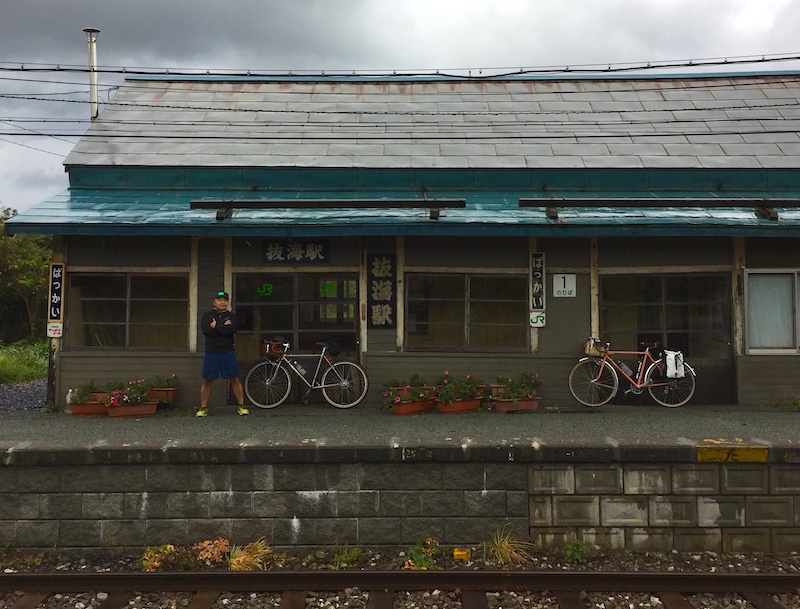
Bakkai station is also famous among railroad enthusiasts, because it’s the northernmost wooden railway station in Japan. After waiting out the rain for two hours, we restart our ride. Fortunately, we are not in a rush today!

We haven’t planned our route in detail – just go south, then turn inland. We cycle on small, empty farm roads that meander through the fields.
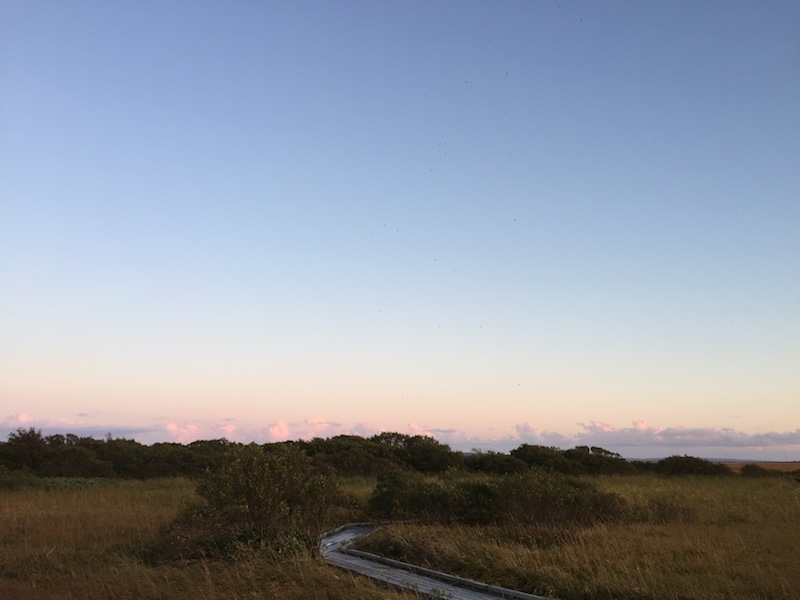
The Sea of Japan is famous for its beautiful sunsets, so we decide to stay on the coast and watch the sunset. The Sarobetsu Wetlands form one of the largest meadows in Japan. The large scale of Hokkaido’s landscape really sinks in here – so different from the steep mountains and deep valleys that make up the rest of Japan. It’s Japan’s ‘Big Sky Country.’
When we arrive, the sun is already setting. There are no tourists at this late hour, and we enjoy the wooden walkways that lead across the meadows. The quiet magnificence makes our visit an almost spiritual experience.

We recall our college antics and jump in the air. When we look at the photos, we laugh: We don’t jump as high as we used to!
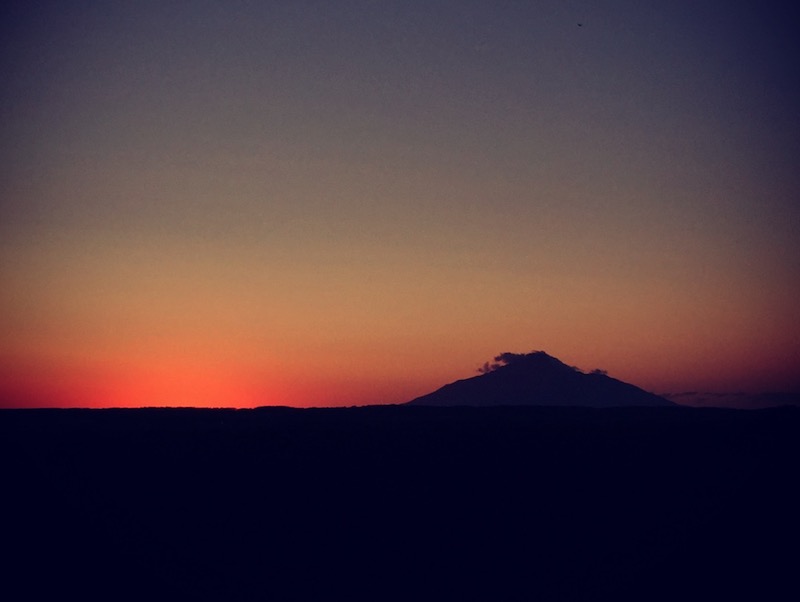
The sun vanishes into the Sea of Japan and illuminates Rishiri Island, a 1700 m (5600 ft) volcano that seems to float on the sea. I decide that, some day, I’ll climb Mt. Rishiri!
The sunset is beautiful, but it also reminds us that we must hurry to our hotel. There are no streetlights in rural Hokkaido! We enjoy half an hour of night riding before arriving at our hotel in complete darkness. (We have good lights.) We head to the Onsen hot bath with its pungent, black water. Even though the reputation of this Onsen is well known, we are surprised how strong the smell and how dark the water really is. Even though I love Onsen, I cannot stay in the water very long. But it is fun!

The next morning, we continue our inland ride until we have crossed over to the Sea of Okhotsk.
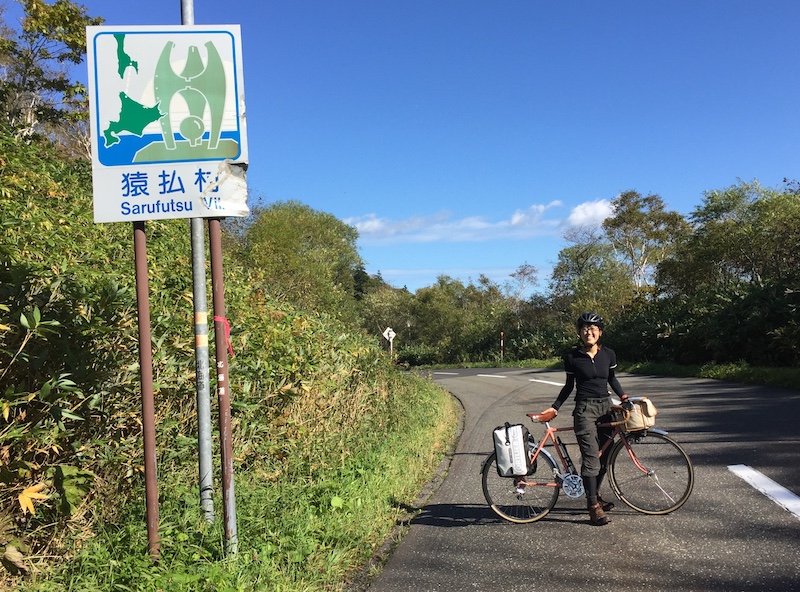
Once again, we don’t have a set route. We check the map and pick small roads toward Sarufutsu village, where our friend Ms. K lives. How about trying some gravel roads? We don’t know how rough the gravel will be… If it’s no fun, we can return to the main road. Today, we have time for exploring.
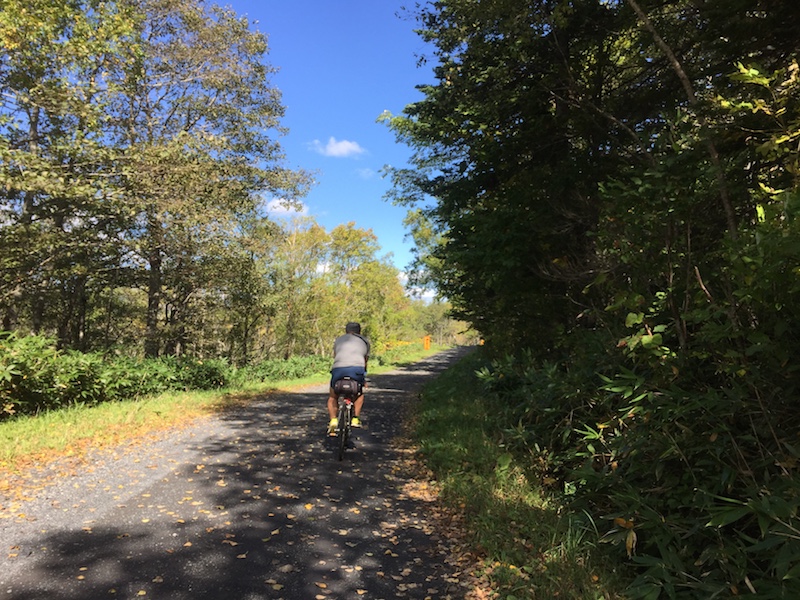
We find a wide farm road that is remarkably smooth, and we follow it for 17 km (10 miles).

Another detour takes us to the North Okhotsk cyclepath. In some parts, this paved path is bumpier than the gravel road we rode on earlier! As a former railroad grade, this path is very flat. My mind wanders, and I imagine old B&W photos of steam trains chugging along this route. Even on this sunny and bright day, I feel nostalgic.
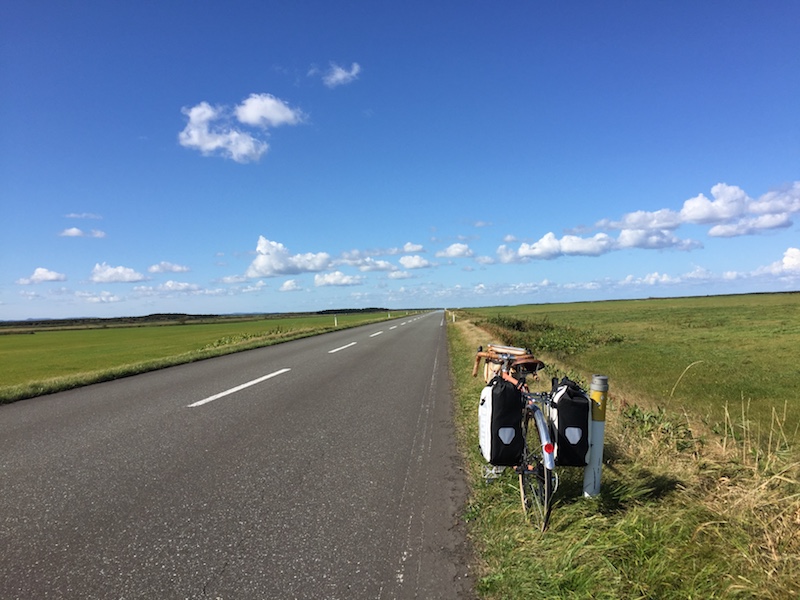
Adding to our collection of roads is the Esanuka Line, which is famous among cyclists and motorbike riders because it spears in a straight line across a totally flat landscape, with not even a power line interrupting its ‘horizontalness.’ For Japanese, riding in a straight line beyond the horizon is very remarkable. For 30 minutes, it feels almost like the famous Route 66 across the American West.
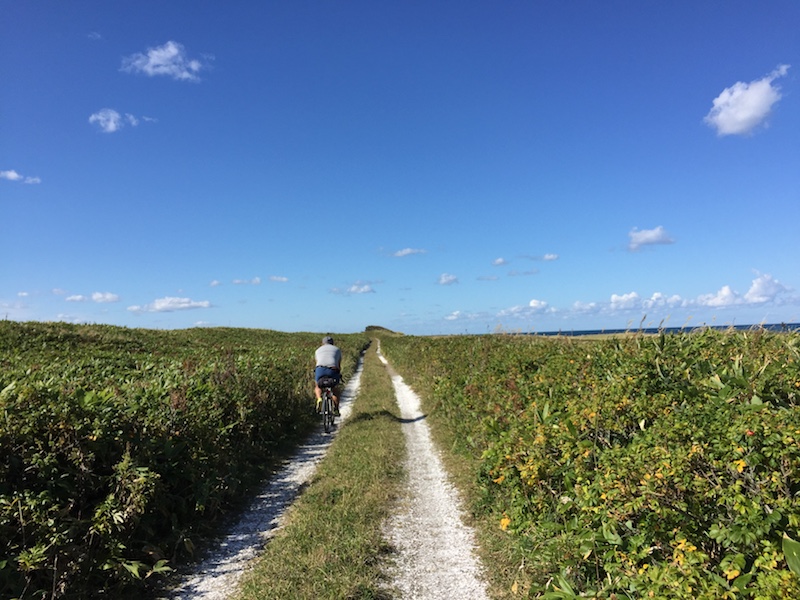
Moving closer to the sea, we find a narrow road paved with white gravel. We can smell the ocean as the stones crunch under our tires. Suddenly, we realize that the road is not paved with stones at all – we are riding on crushed seashells!

Small paths lead to the water. We look over the sea on one side and the landscape of Soya on the other, and we talk about how this region’s great variety and unique feel make it a perfect destination for cyclotourists.

Our cycling trip ends as we pull up at Ms. K’s house. It’s fun to arrive by bike, as if we just had ridden across Tokyo to visit a friend. But nobody is home!
We call Ms. K, and learn that she is waiting on the main road, wanting to surprise us and take our photo as we arrive. But we took a backroad and reached her house from the other side. We laugh about this ‘mishap’ – again, it feels just like our college days.

Sarufutsu is famous for its ‘free-range’ scallops. For dinner, Ms. K teaches us the different ways to cook the fresh mollusks that have been harvested only this morning. We make sashimi, we fry them, and we sautée them with butter. Accompanied by lively conversation, we enjoy our private reunion.

For our last day on Hokkaido, we’ve planned to go sightseeing with Ms. K and her family, but the hard rain keeps us in the car. We talk about our school days, our present lives and our plans for the future – just like we’ve always done when we meet.
I am very happy. Visiting Ms. K together has made the trip even more special. In the past, Mr. Y or I have visited her alone and sent photos, which made the other all the more envious. Now we can all share the fun.

That afternoon, we say goodbye at Wakkanai Airport. Mr. Y has to return to Tokyo, while I will cycle around Hokkaido for another week. This trip has been filled with small adventures and exciting discoveries, and I look forward to more…


